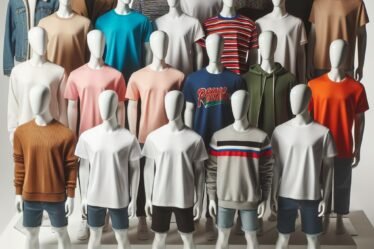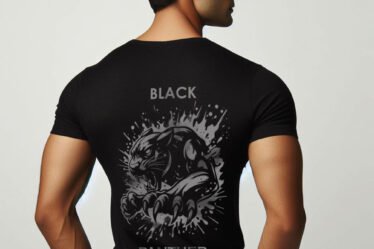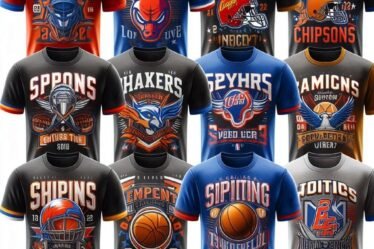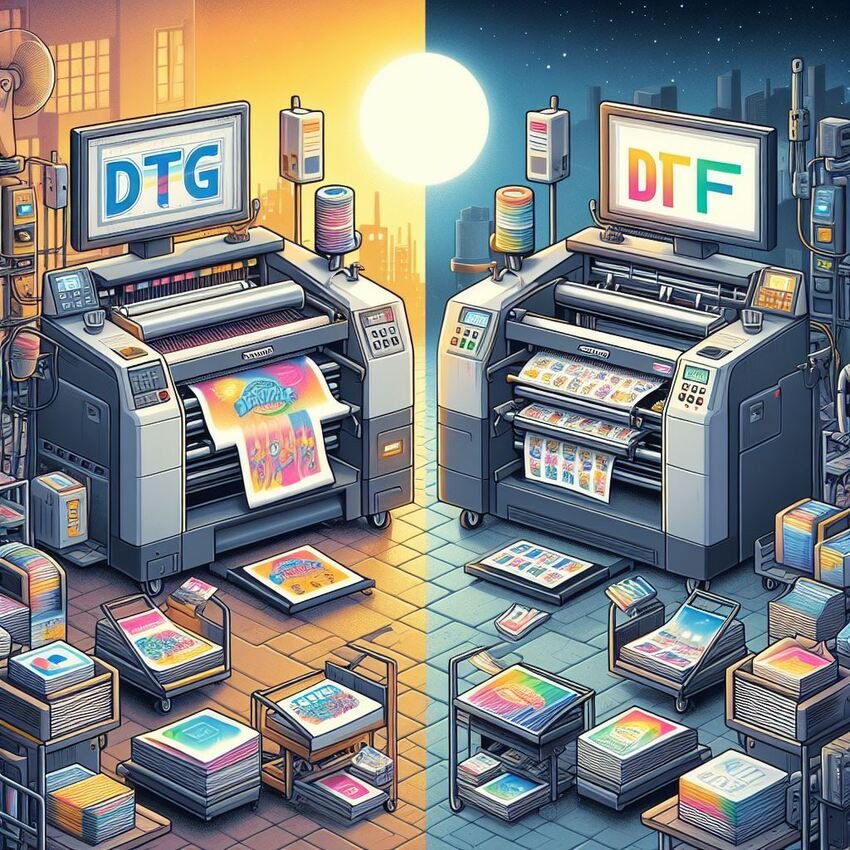
When it comes to designing and printing custom tees, you have two main options: DTG and DTF printing. Let’s dive into what each method entails and help you decide which is the right choice for your personalized shirts. In a previous post, we compared Screen Printing vs Sublimation Printing. In this post, we’re going to compare DTG vs DTF printing.
DTG Printing
DTG printing is like using a high-tech printer to put your design directly onto your t-shirt. It’s perfect for those intricate designs and personalized photos. Here’s a rundown of its pros and cons:
Pros:
- Detailed and Vibrant Prints: DTG ensures your design pops with sharp details and bright colors, making your customized tees stand out.
- Works on Various Fabrics: Whether it’s cotton or blends, DTG printing can customize tees made from different materials.
- No Minimum Orders: You can get even a single printed t-shirt without breaking the bank, perfect for small groups or individualized designs.
- Eco-Friendly: DTG uses water-based inks, making it a greener option compared to other printing methods.
Cons:
- Time-Consuming: Creating your custom design t-shirt might take a bit longer with DTG, especially for intricate or larger orders.
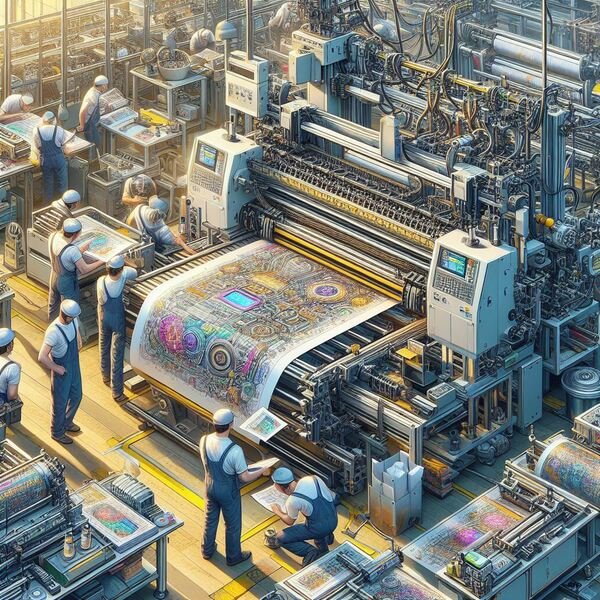
DTF Printing
DTF printing takes a different approach. Instead of printing directly on the tee, your design is first printed on a special film and then transferred onto the tshirt using heat. Here’s what you need to know:
Pros:
- Vibrant Colors: DTF printing brings out the brightness in your colors, even those neon shades, making your design t-shirt pop.
- Quick Turnaround: It’s faster than DTG, making it ideal for larger orders or when time is of the essence.
- Works on Different Fabrics: Just like DTG, DTF printing is versatile and can be used on various fabric types.
- Cost-Effective: Depending on your design and quantity, DTF printing might be more budget-friendly than DTG.
Cons:
- Less Detailed: For super intricate designs, DTF printing might not capture all the fine details as well as DTG.
- Requires Special Equipment: You’ll need specific printers and heat presses, which can be a bit costly upfront.
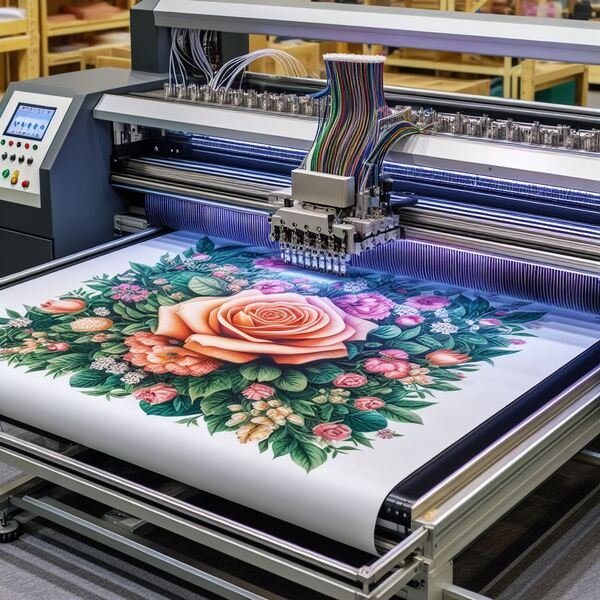
Let’s compare DTG printing and DTF printing techniques in various aspects:
Process
- DTG Printing: DTG printing is like using a special printer for your t-shirt! Instead of printing on paper, it prints directly onto the fabric. This method works for both light and dark-colored shirts, and you can print detailed designs, even photos, with super clear quality. So, whether you want a simple logo or a detailed graphic, DTG printing has got you covered!
- DTF Printing: DTF printing, or Direct-to-Film transfer printing, is another cool way to customize tees! Here’s how it works: first, your design gets printed onto a special film using a specific printer and ink. Then, it’s heat-pressed onto your graphic t-shirt using a heat press machine. This transfers the design onto the fabric. DTF printing is great for both light and dark-colored shirts, and it makes colors pop and details look sharp. Plus, you can use it on different fabrics like cotton and polyester blends to get the perfect printed t-shirt you want!
Fabric Compatibility
- DTG Printing: DTG printing is mainly used for cotton and cotton-blend fabrics, but it can also work on some polyester clothes if they’re pre-treated first. It sticks well to the fabric and stays put even after washing, so your printed t-shirts will look great for a long time!
- DTF Printing: With DTF printing, you have more options because it can work on lots of different fabrics like cotton, polyester, blends, and even some synthetic materials. The sticky stuff used in DTF printing helps the design stick well to all these fabrics, making sure your prints last a long time!
Color Vibrancy and Detail
- DTG Printing: DTG printing brings out colors really well and captures tiny details perfectly, so it’s awesome for fancy designs with lots of colors, shadows, and fine lines. Plus, the printed t-shirts feel soft and smooth, with hardly any texture to them.
- DTF Printing: DTF printing gives you bright colors and sharp details too! The special film used can handle fancy designs with super clear results. But keep in mind, DTF prints might feel a bit thicker than DTG prints because of the film layer on top.
Durability
- DTG Printing: When you treat and dry them right, DTG prints can last through lots of washes without fading. But remember, how long they stay looking good depends on things like what fabric you printed on, how good the ink is, and how you wash them.
- DTF Printing: When you do DTF printing the right way, the prints can stick around through many washes without fading. That’s because the sticky stuff used in DTF printing really grips onto the fabric, making sure your prints stay put for a long time!
Setup and Production Time
- DTG Printing: DTG printing is pretty easy to set up because you can print the design right onto the shirt without any extra steps. That’s why it’s perfect for printing stuff quickly, even if you only need a few shirts done at a time.
- DTF Printing: DTF printing may involve additional steps for printing the transfer film and heat-pressing it onto the garment. However, advancements in DTF technology have streamlined the process, reducing setup and production times compared to traditional methods.
Cost
- DTG Printing: DTG printers and inks may have a higher initial investment cost compared to DTF printing equipment. However, the cost per print can be lower for small to medium-sized orders, as there are no additional consumables required.
- DTF Printing: DTF printing may have lower initial equipment costs compared to DTG printing. However, the cost per print may be slightly higher due to the additional cost of the transfer film.
Conclusion
In the end, it all comes down to what you need for your shirts. If you want super detailed designs and don’t mind spending more on the gear, DTG printing might be perfect for you. But if you’re all about getting lots of shirts done quickly and want those colors to really pop, DTF printing could be just what you’re looking for. So, think about your design, how many shirts you need, and what you’re willing to spend, and then decide which printing method works best for you.

